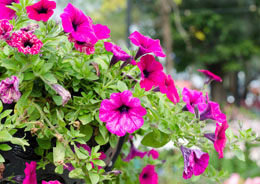The viability of petunia seeds makes them ideal for propagation purposes. You can harvest these seeds on your own, and use them for next year plantation. This Buzzle article provides some tips that you can follow for growing petunia seeds in your garden.

Petunias are popular among hobbyists and flower enthusiasts all over the world. They are well-known for their color diversity and low maintenance levels. You can grow petunia flowers in containers, hanging baskets, regular flower beds, and as borders in the flower garden. In all these growing choices, you will get to enjoy fragile, magnificent blooms in spring or summer season. Petunias are perennials, but mostly maintained as annuals, meaning you need to uproot plants, and replant them every year.
Similar to many other annual flowering plants, petunias produce a large quantity of viable seeds. Hence, if you are interested in harvesting petunia seeds, you can do so for using them in the next planting season. So, for first year plantation, you can purchase these seeds from shops selling garden supplies. In case, you maintain healthy petunia plants, your plants will bear attractive blooms, which mature to seeds. This article highlights on the steps starting from purchasing petunia seeds to sowing, maintaining plants, and harvesting seeds.
How to Grow Petunia Seeds
Petunia seeds are small and difficult to handle while sowing. Considering this, most nurseries provide small plantlets for propagation. Recently, commercial seed suppliers have created pelleted seeds, that are encased in a special coating. Such pelleted seeds are larger and easy to sow. In case you are planning to collect seeds on your own, the quality of harvested petunia seeds depends largely upon how you maintain the parent plants, harvest, and store them. Mentioned below are tips that you can follow for growing petunia seeds in your garden:
Selecting the Seeds
Petunia flowers are found in a wide array of dazzling colors, both in single and multicolored varieties. A popular variety called wave petunia seed exhibits spreading and trailing growth habit. Check out the color options available in your local nursery center. You can opt for blue and pink petunia seeds to create a color pattern in your garden. Also ask the supplier about the germination rate, plant height, and disease susceptibility of the particular varieties.
Buying the Seeds
Petunia seeds are sold in small packets, each of which contains somewhere about 25 - 65 seeds. As per your preference, you can purchase pure seeds in bulk (uncoated form) or pelleted ones. Since pelleted seeds are treated and packaged, they are more expensive than regular seeds. These pelleted seeds, though costly, are easy to handle. They have a better chance of surviving and thriving under field conditions than the untreated ones.
Growing Petunia Seeds
Sow petunia seeds as soon as favorable climatic conditions arrive, either directly in flower garden or indoors in seed trays. For spring blooming cultivars, sow them indoors, 6 - 8 weeks before the first frost arrives. Cover the seeds with soil (about 1/8 inch layer), and water lightly. You can cover a plastic sheet over the pot or tray to promote quick germination. And keep it in a corner that receives indirect sunlight.
Petunia Seeds Germination
Petunia seeds germinate within 10 days after sowing, while some may take about 3 weeks. Remove the plastic sheet as soon as the seeds start sprouting. Place the seedlings in a bright area, but away from direct sunlight. The ideal temperature range to maintain seedlings is 65° F. during day and 55° F. at nighttime. You can transplant the plantlets, when they bear the true leaves.
Maintaining Petunia Plants
The petunia plantlets are ready for transplantation within 8 - 10 weeks after sowing. Harden them before transplantation by placing outdoors in bright light during day time. After frosting is over, and when the soil temperature measures 60 degrees F, transplant petunia plants in well-drained garden soil. The plants will grow to about 12 - 15 inches tall. Encourage them to bear flowers.
Harvesting the Seeds
As the petunia flowers fade and mature, they produce seeds in a seedpod at the lower portion of the flower. In order to extend flowering period, you can pinch of the flowers. Or else, allow a few of them to dieback naturally for seed harvesting. When the blooms dry out, pinch at the base, and store them in an airtight container. The pods will open and release seeds. This way, you can harvest petunia seeds.
Store these seeds in a cool and dry area, until the return of favorable growth conditions. Follow the same steps mentioned above to sow seeds of petunia, and transplant petunia plantlets. So, this was all about selecting, planting, and harvesting petunia seeds.






 Petunias are popular among hobbyists and flower enthusiasts all over the world. They are well-known for their color diversity and low maintenance levels. You can grow petunia flowers in containers, hanging baskets, regular flower beds, and as borders in the flower garden. In all these growing choices, you will get to enjoy fragile, magnificent blooms in spring or summer season. Petunias are perennials, but mostly maintained as annuals, meaning you need to uproot plants, and replant them every year.
Petunias are popular among hobbyists and flower enthusiasts all over the world. They are well-known for their color diversity and low maintenance levels. You can grow petunia flowers in containers, hanging baskets, regular flower beds, and as borders in the flower garden. In all these growing choices, you will get to enjoy fragile, magnificent blooms in spring or summer season. Petunias are perennials, but mostly maintained as annuals, meaning you need to uproot plants, and replant them every year.